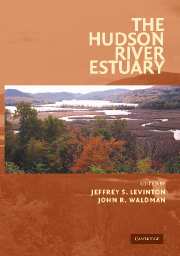Book contents
- Frontmatter
- Contents
- Preface
- List of Contributors
- The Hudson River Estuary
- 1 The Hudson River Estuary: Executive Summary
- GEOLOGICAL, PHYSICAL, AND CHEMICAL SETTING OF THE HUDSON
- PRIMARY PRODUCTION, MICROBIAL DYNAMICS, AND NUTRIENT DYNAMICS OF THE HUDSON
- HUDSON RIVER COMMUNITIES, FOOD WEBS, AND FISHERIES
- 12 Larval Migrations Between the Hudson River Estuary and New York Bight
- 13 The Diadromous Fish Fauna of the Hudson River: Life Histories, Conservation Concerns, and Research Avenues
- 14 Fisheries of the Hudson River Estuary
- 15 The Role of Tributaries in the Biology of Hudson River Fishes
- 16 Ecology of the Hudson River Zooplankton Community
- 17 Submersed Macrophyte Distribution and Function in the Tidal Freshwater Hudson River
- 18 Long-Term and Large-Scale Patterns in the Benthic Communities of New York Harbor
- 19 The Benthic Animal Communities of the Tidal-Freshwater Hudson River Estuary
- 20 Tidal Wetlands of the Hudson River Estuary
- 21 Alien Species in the Hudson River
- CONTAMINANTS AND MANAGEMENT ISSUES OF THE HUDSON RIVER ESTUARY
- Index
- Plate section
- References
16 - Ecology of the Hudson River Zooplankton Community
Published online by Cambridge University Press: 06 January 2010
- Frontmatter
- Contents
- Preface
- List of Contributors
- The Hudson River Estuary
- 1 The Hudson River Estuary: Executive Summary
- GEOLOGICAL, PHYSICAL, AND CHEMICAL SETTING OF THE HUDSON
- PRIMARY PRODUCTION, MICROBIAL DYNAMICS, AND NUTRIENT DYNAMICS OF THE HUDSON
- HUDSON RIVER COMMUNITIES, FOOD WEBS, AND FISHERIES
- 12 Larval Migrations Between the Hudson River Estuary and New York Bight
- 13 The Diadromous Fish Fauna of the Hudson River: Life Histories, Conservation Concerns, and Research Avenues
- 14 Fisheries of the Hudson River Estuary
- 15 The Role of Tributaries in the Biology of Hudson River Fishes
- 16 Ecology of the Hudson River Zooplankton Community
- 17 Submersed Macrophyte Distribution and Function in the Tidal Freshwater Hudson River
- 18 Long-Term and Large-Scale Patterns in the Benthic Communities of New York Harbor
- 19 The Benthic Animal Communities of the Tidal-Freshwater Hudson River Estuary
- 20 Tidal Wetlands of the Hudson River Estuary
- 21 Alien Species in the Hudson River
- CONTAMINANTS AND MANAGEMENT ISSUES OF THE HUDSON RIVER ESTUARY
- Index
- Plate section
- References
Summary
abstract Zooplankton in the Hudson River estuary include both freshwater and estuarine species and range in body lengths from microns to millimeters. Measurements of abundance and biomass as well as community rate processes indicate that zooplankton do not generally exert significant grazing pressure on phytoplankton. In addition, recycling of nutrients by zooplankton is not significant to primary producers because concentrations of dissolved nutrients are quite high in the Hudson and controlled by other processes. Zooplankton do provide an important linkage in the food web as they are key prey items for many young-of-year fish as well as fish that are primarily planktivorous throughout life. Long-term observations indicate many zooplankton populations undergo regular seasonal cycles in abundance, typically with increases during warm, low-flow periods of the year. The invasion of the zebra mussel into the Hudson had strong impacts on zooplankton in the freshwater section of the estuary. Microzooplankton such as rotifers declined dramatically. Cladocerans also declined in annual average abundance between pre- and post-zebra mussel periods when the effects of wet and dry years are taken into account. Zebra mussels, however, had little effect on larger zooplankton. Regulation of zooplankton appears to be a function of physical forces that affect population residence times as well as food and predators. Evidence for food limitation is mixed. Some species benefit from food supplements in experimental trials, but the reduction of phytoplankton biomass in association with the zebra mussel invasion had no effect on cladoceran egg production. There are a variety of potential predators, and calculations indicate fish exert high rates of mortality on zooplankton.
- Type
- Chapter
- Information
- The Hudson River Estuary , pp. 217 - 229Publisher: Cambridge University PressPrint publication year: 2006
References
- 2
- Cited by



